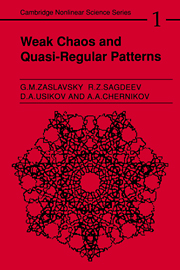2 - Stability and chaos
Published online by Cambridge University Press: 29 October 2009
Summary
Situations in which the system's integrability is immediately evident are very rare. Far more often, one has to do with a problem where a small perturbation is added to an otherwise integrable system. A large variety of methods and developed techniques exist to help analyse the effect of a perturbation on a system. Each is, in one way or another, related to the problem of a system's stability. Here one should remember that both the formulation of the stability problem and the very concept of stability are highly conditional. Any particular question concerning the system's properties determines not only the method of solution, but a specific definition of stability as well. For instance, the small perturbations may result in a weak response of the system's parameters either during a certain finite time interval or during an infinite time. In the latter case, the phase space topology of the system may either remain unchanged or may change considerably, etc.
Recently, studies on the stability of dynamic systems have been enriched by new methods and concepts. This is due to the discovery of a new phenomenon – dynamic chaos (or, simply, chaos). It turns out that while the equations may show no trace of random sources, the trajectories of a system can be the result of random time-dependent processes. The property of chaos characterizes the system as non-integrable. It is inherent only in nonlinear systems.
In this chapter we shall provide the most essential information on stability and chaos in dynamic systems. (Note 2.1)
Nonlinear resonance
Nonlinear resonance is an essential property of dynamic systems.
- Type
- Chapter
- Information
- Weak Chaos and Quasi-Regular Patterns , pp. 21 - 35Publisher: Cambridge University PressPrint publication year: 1991



